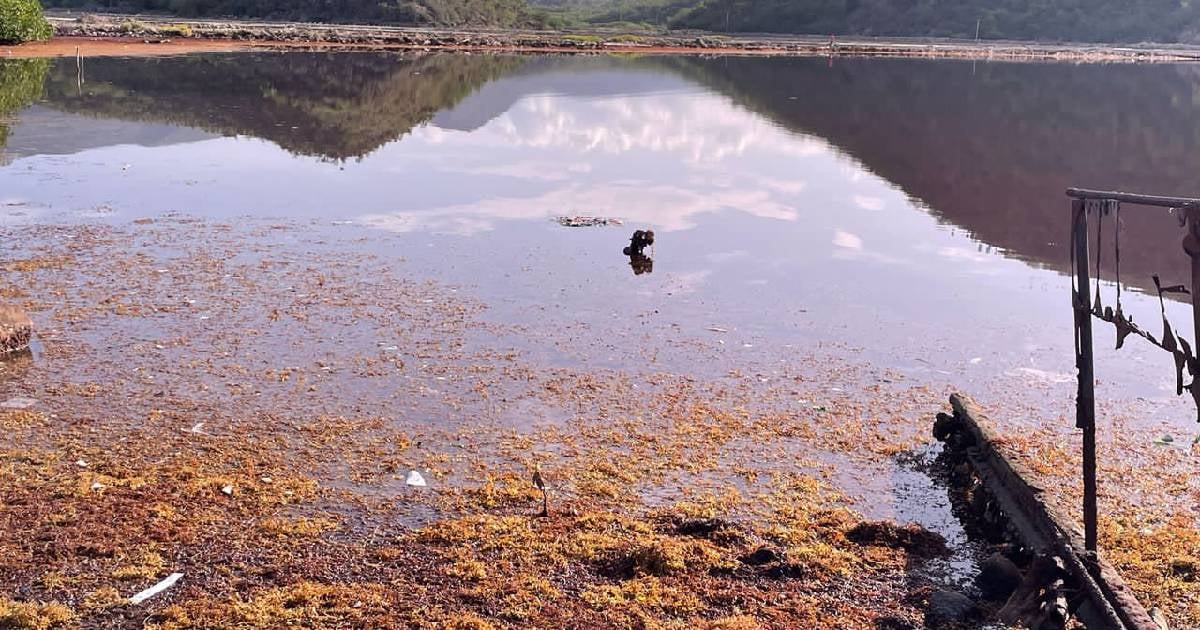The sargassum tide has struck the shores of Guantánamo province with unprecedented force, particularly affecting Baitiquirí Bay. Here, the decomposing seaweed has created unsanitary conditions, emitting foul odors and toxic gases. Residents are experiencing symptoms such as headaches and nausea, attributed to hydrogen sulfide, ammonia, and methane released by the rotting macroalgae, according to Iroel Cantillo Cartaya, a specialist from the Ministry of Science, Technology, and Environment (CITMA) in San Antonio del Sur, as reported by the state newspaper Venceremos.
Health authorities are urging residents to avoid contact with the seaweed, refrain from swimming or walking in affected areas, and wear masks as a preventive measure. Public meetings are being held to inform locals about the risks. However, the municipality lacks the technical resources needed to tackle the issue effectively. Cleaning Baitiquirí Bay is deemed nearly impossible due to the extent of the problem.
Environmental and Human Health at Risk
While efforts are made to clear beaches like Sabanalamar, Los Siguatos, El Guanal, and Yateritas before summer, this is contingent on a reduction in sargassum accumulation by July. Even then, the advanced state of decomposition will pose further health and logistical challenges. A long-term solution for managing the seaweed after removal remains elusive. Cantillo highlighted the lack of technology for potential utilization, with the current strategy being to transport the sargassum away from bathing areas to dry and reduce emissions of gases and odors.
The environmental impact is equally concerning. Sargassum on the coast blocks sunlight crucial for coral reefs, suffocates marine life as it sinks, and causes the death of numerous creatures that inhabit these algae when it washes ashore. While in open water, it may be part of a balanced ecosystem; on the coast, it becomes a direct threat to biodiversity, public health, and local tourism, as noted by the specialist.
Regional Disparities in Response
Despite acknowledgment of the threat by the Civil Defense in their Directive No.1/2022 for disaster risk reduction, and ongoing studies by CITMA, the Institute of Marine Sciences, and Cuban universities, the most affected areas remain under-equipped to handle this environmental crisis. The resilience of an exposed population is being tested as they endure without adequate solutions.
On June 23, CITMA issued a maximum alert for the massive arrival of sargassum on Guantánamo's coasts. Simultaneously, the Empresa Pesquera Guantánamo warned on social media about the phenomenon's scale, coinciding with the summer onset, disrupting fishing, beach recreation, and other marine activities. Local journalist Miguel Noticias described the situation as a "sargassum strike," detailing the severe environmental conditions the area faces.
This environmental phenomenon is driven by interconnected global factors. Massive nutrient discharges, particularly nitrogen and phosphorus from large rivers like the Amazon, combined with climate change and shifting ocean currents, have fostered ideal conditions for excessive sargassum growth in the tropical Atlantic, which is then carried to the Caribbean.
The response capacity varies widely among affected countries. Mexico has adopted a comprehensive approach with containment barriers, specialized vessels, and processing plants. In stark contrast, Cuba struggles with significant equipment and technology limitations. Other Caribbean nations like the Dominican Republic have implemented preventive measures, such as floating barriers, temporary beach closures, and public health campaigns. Concurrently, alternative uses for the algae are being explored, including conversion into building materials and agricultural products, though these solutions are not yet feasible on a large scale.
Given the magnitude of the issue, the scientific community emphasizes the urgency of a unified regional approach. Priorities include satellite monitoring systems, open-sea collection mechanisms, processing infrastructure development, and creating value chains to transform this nuisance into an economic resource.
Frequently Asked Questions about Sargassum Impact in Guantánamo
What health risks are associated with sargassum decomposition?
Decomposing sargassum releases gases such as hydrogen sulfide, ammonia, and methane, which can lead to symptoms like headaches and nausea in humans.
How are local authorities addressing the sargassum problem?
Authorities are urging residents to avoid contact with the seaweed and holding public meetings to raise awareness, but they lack the resources for effective cleanup and management.
What are the environmental impacts of sargassum on the coast?
Sargassum can block sunlight necessary for coral reefs, suffocate marine life, and cause the death of many creatures when it reaches the shore.
What are some potential solutions being explored for sargassum management?
Potential solutions include the use of containment barriers, specialized equipment for collection, and processing the seaweed into usable products like building materials.
